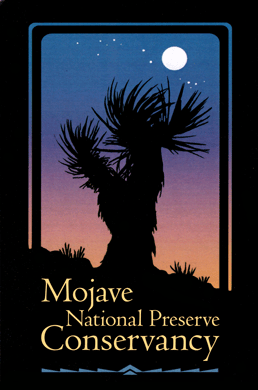A Sweden-based company is proposing to build a massive wind project in southern Nevada along the Mojave National Preserve's northeastern boundary. The Crescent Peak Wind project would involve as many as 220 wind turbines, each towering over 400 feet high. The project would span across nearly 50 square miles of public land, and require the construction of at least 93 miles of new access roads through Joshua tree woodland, desert grassland and blackbush scrub habitat.
A map showing the location of the proposed Crescent Peak Wind project, immediately east of the Preserve's border near the Castle Peaks.
The Mojave National Preserve Conservancy joined a coalition of other conservation groups to oppose the proposed Crescent Peak Wind project and call on the Bureau of Land Management to protect this portion of the largest Joshua tree woodland in the world. Renewable energy is absolutely critical to reduce greenhouse gas emissions and to address climate change. But we can generate clean energy through rooftop solar and renewable energy projects built on already-disturbed lands.
A Say's phoebe perched on a Joshua tree in the proposed Crescent Peak Wind project area, northeast of the Mojave National Preserve.
In comments that the Conservancy submitted to the BLM, we expressed concern that the Crescent Peak Wind project could hinder desert bighorn sheep movement between the New York Mountains in California and McCullough Range in Nevada. Bighorn can be skittish and may be deterred from crossing through a 50 square-mile industrial zone to seek forage and water in other portions of the Mojave. This is a problem because human developments have already begun to isolate populations of desert bighorn sheep, leading to a decline in genetic diversity, according to research. This leaves the bighorn more vulnerable and less resilient to future threats, natural or human-caused.
The project is also proposed for a portion of the Mojave that has one of the highest densities of golden eagle nesting locations. Golden eagles are particularly vulnerable to collision with wind turbines. When they circle above the desert searching for prey, they are focused on scanning the ground below and oblivious to spinning turbine blades.
The Crescent Peak area along the Mojave National Preserve's northeastern boundary is part of the world's largest Joshua tree woodland, rich in native plant and animal life.
The Conservancy also believes that the construction and maintenance activity would introduce more invasive species, such as red brome, thereby increasing the risk of wildfire in the region. Wind turbine occassionally fail and catch fire, and construction activity can also spark blazes. Along with any increase in non-native grass species that often exacerbate the intensity of fires, this giant Joshua tree woodland would be at increased risk. The Hackberry Fire of 2005 in the Preserve devastated nearly 70,736 acres of desert habitat, and it will take decades for the native vegetation to recover.
In addition, the wind project would be built in an area of southern Nevada prized for primitive recreation, where visitors can enjoy a wild setting where human development is minimal. The wind turbines would be visible from the eastern Mojave National Preserve, including from the famous Castle Peaks, and the newly-established Castle Mountains National Monument.
The Bureau of Land Management will be preparing a draft environmental impact study (EIS) this year. The releaseof the draft EIS will present another opportunity for the public - including fellow friends of the Preserve - to submit comments. Stay tuned.
A leopard lizard peers back at the photographer from the safety of a Mojave yucca on the proposed Crescent Peak wind project site.

